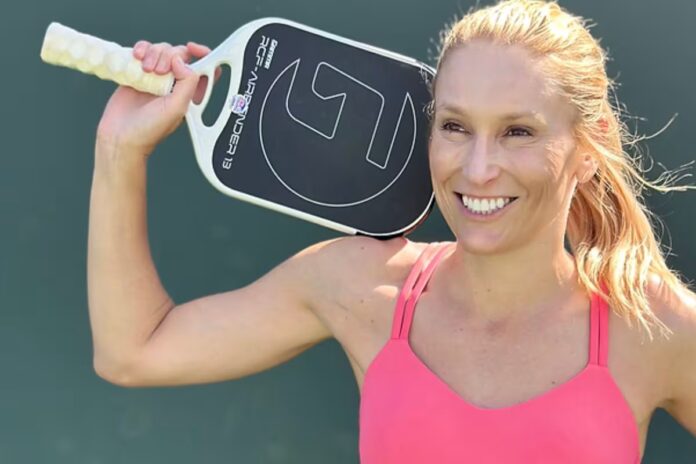Jill Braverman’s Strategic Cross-Court Pickleball Tips: Cross-court speedups are often labeled as low-percentage plays in pickleball. The rationale is straightforward: the margin for error is minimal. When players attack cross-court, they move a longer distance with less room for error in executing a precise shot that remains in bounds. The stakes rise even higher when opponents are positioned to react quickly, often prepared to let the ball sail out if it veers too wide.
However, during a recent match, Jill Braverman showed that a well-executed cross-court attack can indeed yield impressive results, provided it’s approached with the right technique and strategy.
Scanning for Opportunities
In the heat of the moment, as a high, slow bouncer approached her forehand side, Jill Braverman was quick to seize the opportunity. With a swift motion, she raised her paddle, readying herself for the impending speedup.
Her keen observation of her opponent’s positioning revealed Todd Fought, stationed on the right side of the court, aggressively squeezing the middle—a tactic frequently employed at advanced levels of play, especially in mixed doubles. This setup gave Jill Braverman a clear signal: a substantial gap existed on Todd Fought’s left side, beckoning for an attack.
Creating Deceptive Angles
As Todd Fought edged closer to the net, he made a subtle shift toward the middle, attempting to cover any potential threats. Yet, Jill Braverman’s sharp eyes spotted the considerable gap remaining on his left. At this critical juncture, she dropped her paddle head while ensuring it remained squarely aimed at her opponents.
This move achieved two vital objectives:
- Power Maintenance: By keeping her paddle poised, she preserved the power necessary for an effective speedup.
- Concealment: The drop in her paddle direction masked her shot’s true intent, leaving her opponents guessing.
Although Jill Braverman had identified her target—Todd Fought’s left side—this pause before her swing was instrumental in forcing both opponents to consider where the impending attack might land.
Targeting the Weakness
Examining the court, one could see the positions of Emily Cederquist and Todd Fought. Emily Cederquist was preparing her backhand for a potential counter, strategically covering the space between herself and Todd Fought, while he had his paddle lowered, bracing for an attack directed at his body or the court’s middle.
What neither player anticipated, however, was Jill Braverman’s wide-angle assault. She expertly placed her shot far to Todd Fought’s left, catching him unawares. In his effort to respond, Todd Fought overextended, leading to a mishit that ultimately landed in the net.
Implementing the Strategy
For players frequently facing opponents who crowd the middle or attempt to “play big” by covering more court than they can realistically defend, this cross-court attack is a skill worth mastering.
By aiming for the open space beyond their reach, particularly when their positioning leaves them exposed, players can transform what is often considered a risky shot into a smart, high-reward strategy.
News in Brief: Jill Braverman’s Strategic Cross-Court Pickleball Tips
Jill Braverman showed the effectiveness of the cross-court attack during a recent pickleball match, showing how proper technique can turn a low-percentage play into a strategic advantage.
Her analysis revealed the importance of scanning the court, maintaining deceptiveness, and targeting gaps in opponents’ coverage. This tactical approach can be invaluable for players facing those who crowd the middle, making it a must-know move for enhancing gameplay.
ALSO READ: Master the Art of Powerful Serving in Pickleball, Tips to Take Control of the Court!

